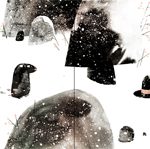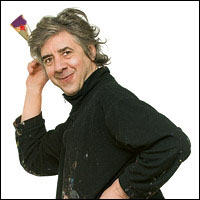 Writing books is a very mysterious thing. At least it is for me. I’ve always enjoyed writing, maybe just as much as I’ve enjoyed drawing, but drawings are easier to gauge. When you create a drawing you like, you can look at it and immediately see the reasons why, and you can show it to other people and they can point to things that they like about it, too.
Writing books is a very mysterious thing. At least it is for me. I’ve always enjoyed writing, maybe just as much as I’ve enjoyed drawing, but drawings are easier to gauge. When you create a drawing you like, you can look at it and immediately see the reasons why, and you can show it to other people and they can point to things that they like about it, too.Guest Blogger: Jon Klassen
 Writing books is a very mysterious thing. At least it is for me. I’ve always enjoyed writing, maybe just as much as I’ve enjoyed drawing, but drawings are easier to gauge. When you create a drawing you like, you can look at it and immediately see the reasons why, and you can show it to other people and they can point to things that they like about it, too.
Writing books is a very mysterious thing. At least it is for me. I’ve always enjoyed writing, maybe just as much as I’ve enjoyed drawing, but drawings are easier to gauge. When you create a drawing you like, you can look at it and immediately see the reasons why, and you can show it to other people and they can point to things that they like about it, too.


 My work often asks, “What is a book?” First came the interactive Press Here, which was radical in its simplicity. For Mix It Up!, I painted with my bare hands—a “no-illustration” illustration. Let’s Play! (2016; all Chronicle) is the return to expressing something with drawing, composition, proportion, and feelings.
My work often asks, “What is a book?” First came the interactive Press Here, which was radical in its simplicity. For Mix It Up!, I painted with my bare hands—a “no-illustration” illustration. Let’s Play! (2016; all Chronicle) is the return to expressing something with drawing, composition, proportion, and feelings.
 Not long after my dad died, just after Christmas in 1999, I found myself in the throes of intense grief. I had experienced loss before. Grandparents had passed away. Friends had left me, too. But I had never felt the kind of profound sadness that engulfed me when my father died. It caused my knees to buckle and for months I felt like I was slogging through quicksand, each step muddier than the one before it.
Not long after my dad died, just after Christmas in 1999, I found myself in the throes of intense grief. I had experienced loss before. Grandparents had passed away. Friends had left me, too. But I had never felt the kind of profound sadness that engulfed me when my father died. It caused my knees to buckle and for months I felt like I was slogging through quicksand, each step muddier than the one before it. I remember it clearly—the day the inspiration for Papa’s Mechanical Fish (Farrar, 2013) fell in my lap. I was sitting cross-legged on the basement floor of the Old Lighthouse Museum in Michigan City, Indiana, rummaging through a box of photographs when a crumbling, decades-old booklet slipped out from a manila folder.
I remember it clearly—the day the inspiration for Papa’s Mechanical Fish (Farrar, 2013) fell in my lap. I was sitting cross-legged on the basement floor of the Old Lighthouse Museum in Michigan City, Indiana, rummaging through a box of photographs when a crumbling, decades-old booklet slipped out from a manila folder. Yes, it’s true. I have always loved concept books. ABCs, one-two-threes, reds yellows blues, you name a concept book – chances are, I loved it.
Yes, it’s true. I have always loved concept books. ABCs, one-two-threes, reds yellows blues, you name a concept book – chances are, I loved it. Forty years ago, when I was a young writer, and enjoying some success with my first novel, La Guerre, Yes Sir! (Éditions du jour, 1968), I was invited to write a story for the Canadian Broadcasting Corporation (CBC). I wanted to write about the moment that I felt, for the very first time, that I was my own person—not my mother’s son, not my father’s son—but me, petit Roch.
Forty years ago, when I was a young writer, and enjoying some success with my first novel, La Guerre, Yes Sir! (Éditions du jour, 1968), I was invited to write a story for the Canadian Broadcasting Corporation (CBC). I wanted to write about the moment that I felt, for the very first time, that I was my own person—not my mother’s son, not my father’s son—but me, petit Roch.